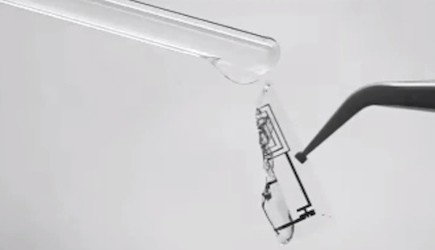Transient Electronics Dissolve in Liquid
October 03, 2012
on
on

Biomedical engineers have created electronic devices that wink out of existence at a predetermined point in time.
They’re called transient electronics and are the result of a collaboration of Tufts Univeristy, University of Illinois and the Defense Advanced Research Projects Agency (DARPA).
The engineers build tiny electronic systems on ultrathin sheets of silicon of a few tens of nanometers thick. When exposed to liquid like water or biofluids the device dissolves breaking down in traces of silicon and magnesium. Because of their small amount these components can be harmlessly assimilated by biosystems like the human body.
'Transient electronics offer robust performance comparable to current devices but they will fully resorb into their environment at a prescribed time—ranging from minutes to years, depending on the application', Fiorenzo Omenetto, professor of biomedical engineering at Tufts School of Engineering explains. 'Imagine the environmental benefits if cell phones, for example, could just dissolve instead of languishing in landfills for years.'
To control the life span of the nanoscale electronics, the team encapsulated them in silk proteins. The silk protects the components for a certain period against dissolution. The exact amount of time is determined by manipulating the properties of the silk.
Besides being an environmentally friendly alternative to conventional electronics, transient electronics can be used for biomedical applications. In some instances it could replace the use of antibiotics. Artificial implants like pacemakers can cause local infections. Instead of pumping the patient full of antibiotics messing up his or her immune system, the implant could be encapsulated in a thin heating device. If an infection occurs, the device could produce heat locally imitating a fever and killing the bacteria.
DARPA sees possibilities for on-duty soldiers who need temporary implants. Because the device dissolves over time, instead of coming back in for an extraction surgery they can keep on fighting. Bunch of tough guys and girls them warrior folk.
A paper describing the findings appeared in the Science issue of September 28 [paywalled].
Sources: DARPA and Tuft University
They’re called transient electronics and are the result of a collaboration of Tufts Univeristy, University of Illinois and the Defense Advanced Research Projects Agency (DARPA).
The engineers build tiny electronic systems on ultrathin sheets of silicon of a few tens of nanometers thick. When exposed to liquid like water or biofluids the device dissolves breaking down in traces of silicon and magnesium. Because of their small amount these components can be harmlessly assimilated by biosystems like the human body.
'Transient electronics offer robust performance comparable to current devices but they will fully resorb into their environment at a prescribed time—ranging from minutes to years, depending on the application', Fiorenzo Omenetto, professor of biomedical engineering at Tufts School of Engineering explains. 'Imagine the environmental benefits if cell phones, for example, could just dissolve instead of languishing in landfills for years.'
To control the life span of the nanoscale electronics, the team encapsulated them in silk proteins. The silk protects the components for a certain period against dissolution. The exact amount of time is determined by manipulating the properties of the silk.
Besides being an environmentally friendly alternative to conventional electronics, transient electronics can be used for biomedical applications. In some instances it could replace the use of antibiotics. Artificial implants like pacemakers can cause local infections. Instead of pumping the patient full of antibiotics messing up his or her immune system, the implant could be encapsulated in a thin heating device. If an infection occurs, the device could produce heat locally imitating a fever and killing the bacteria.
DARPA sees possibilities for on-duty soldiers who need temporary implants. Because the device dissolves over time, instead of coming back in for an extraction surgery they can keep on fighting. Bunch of tough guys and girls them warrior folk.
A paper describing the findings appeared in the Science issue of September 28 [paywalled].
Sources: DARPA and Tuft University
Read full article
Hide full article



Discussion (1 comment)
Paul 12 years ago